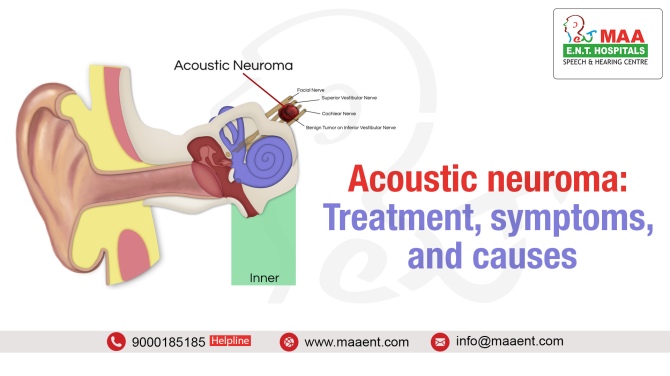 Acoustic neuroma is a rare noncancerous tumor. It grows slowly from an overproduction of Schwann cells and is also called a vestibular schwannoma. The tumor then presses on the hearing and balance nerves in the inner ear. Schwann cells normally wrap around and support nerve fibers. A large tumor can press on the facial nerve or brain structures.
Acoustic neuroma is a rare noncancerous tumor. It grows slowly from an overproduction of Schwann cells and is also called a vestibular schwannoma. The tumor then presses on the hearing and balance nerves in the inner ear. Schwann cells normally wrap around and support nerve fibers. A large tumor can press on the facial nerve or brain structures.
There are 2 types of acoustic neuromas:
Unilateral acoustic neuromas. This type affects only one ear. It is the most common type of acoustic neuroma. This tumor may develop at any age. It most often happens between the ages of 30 and 60. Acoustic neuroma may be the result of nerve damage caused by environmental factors. No environmental factor has been shown to cause acoustic neuromas.
Bilateral acoustic neuromas. This type affects both ears and is inherited. It is caused by a genetic problem called neurofibromatosis-2 (NF2).
What are the causes of acoustic neuroma?
Acoustic neuroma can be caused by:
- Constant or continuous exposure to loud noise (such as music or work related noise)
- Neck or face radiation can lead to acoustic neuroma many years later.
People who have a disease called neurofibromatosis type 2 (NF2) are at higher risk. NF2 can run in families.
What are the symptoms of acoustic neuroma?
These are the most common symptoms of acoustic neuroma:
- Hearing loss on one side, can’t hear high frequency sounds
- Feeling of fullness in the ear
- A ringing in the ear (tinnitus), on the side of the tumor
- Dizziness
- Balance problems or unsteadiness
- Facial numbness and tingling with possible, though rare, paralysis of a facial nerve
- Headaches, clumsy gait, and mental confusion
The symptoms of acoustic neuroma may look like other conditions or health problems. Always talk with your healthcare provider for a diagnosis.
How is acoustic neuroma diagnosed?
Acoustic neuromas look like other middle and inner ear problems. It may be hard to diagnose. An ear exam and a hearing test are usually done first. Computerized tomography (CT scan) and magnetic resonance imaging scans (MRI) help to find and measure the tumor.
How is acoustic neuroma treated?
Your healthcare provider will figure out the best treatment based on:
- How old you are
- Your overall health and health history
- How sick you are
- How well you can handle specific medicines, procedures, or therapies
- How long the condition is expected to last
- Your opinion or preference
Treatment may include watching and waiting, surgery, or radiation. Surgery for larger tumors can damage hearing, balance, and facial nerves. Another treatment choice is radiosurgery, often called the “gamma knife.” This uses focused radiation to reduce the size or blunt the growth of the tumor.
What are the complications of acoustic neuroma?
If the tumor gets big enough, it can press against the brain stem. This can affect neurological function or even become life-threatening.
Few points about acoustic neuroma
- Acoustic neuroma is a noncancerous tumor. It affects hearing and balance when the tumor presses on the nerves in the inner ear.
- It must be diagnosed using hearing tests and imaging tests.
- Treatment can include watching and waiting, surgery, or radiation. It is a rare tumor that often affects middle-aged people.
